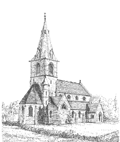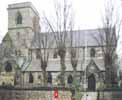For this church:    |
|
 The
Foundation Stone The
Foundation Stone |
 Quill
used by the Quill
used by thePrince of Wales |
The Duke died in 1864, and following this a great deal of work was done in the chancel by the Duke’s family and friends. In 1906 a project was launched to “beautify the chancel” and the roof was boarded over and painted in the manner still visible today to match the decorations in the nave of the church.
The organ was moved in the early 1970s as it was felt that the curtain wall was interfering with the acoustics of the music between the choir and the nave. It does not sit easily in its current position and the changes at the front of the church have never been completed.
About the same time a small statue of St Luke, which stood in a colonnaded niche on the West Wall, was also dismantled as it had become dangerous.
Recently documentation has been examined which reveals that the problems with the spire and damp are not new - the report is dated 1877. This report also perhaps sheds light on the major change to the building since it was built, the removal of the spire.
Plans have also been found for a proposed small chapel to be added in an upper room in the church. It is reckoned that this must be in the former organ loft, but there is no knowledge now of what was proposed to be done with the organ or even if there was one there at the time (about 1880) although as far as can be ascertained most of the fittings are original.
The Removal of the Spire
Pictures of the church with its spire seem to be few and far between, and none as yet located show it in colour. There are numerous stories in the village about the reasons for the removal of the spire. Examination of all the available documentation reveals some interesting facts and the following is no more than an attempt to record our present understanding of the problems under the church.
 Drawing
of the Drawing
of theChurch before the Removal of the Spire |
In 1973 the spire was removed as it was becoming unsafe. This was largely financed by money from the coal board who denied liability but made an ex gratia payment. There was considerable settlement around the tower soon after the church was built and a report of 1877 highlights the problems and reasons for this happening. The church is built on bedrock and this slopes down from the west end of the church to about 5' 6" under the chancel. Water is running over this and affecting the concrete of the footings and the damp is then rising up the walls into the church. This is noted in the report of 1877 and it also raises some questions about what could happen if the area under the church was drained.
It seems likely that in response to this report a ditch was dug that used to exist at the East end of the church. This was just outside the then graveyard wall, the footings of which are still visible. This is known to have been deep and may well have reached to the level of the bedrock. This was filled in when the churchyard was extended in about 1940. It seems clear that what has happened since is the continuation of a process noted as occurring only 15 years after the church was built. The subsidence to the tower and spire and the movements that caused the danger to the church in both 1877 and 1975 may well have origins that were not wholly related to mining but also due to problems much nearer the surface. The report of 1877 also notes that sudden movements have been noticed after prolonged wet weather: 1974 and 1975 were both wet summers. The church continues to suffer from damp and this explains the efflorescence seen on the walls, although all movement of the foundations has ceased at the moment.






